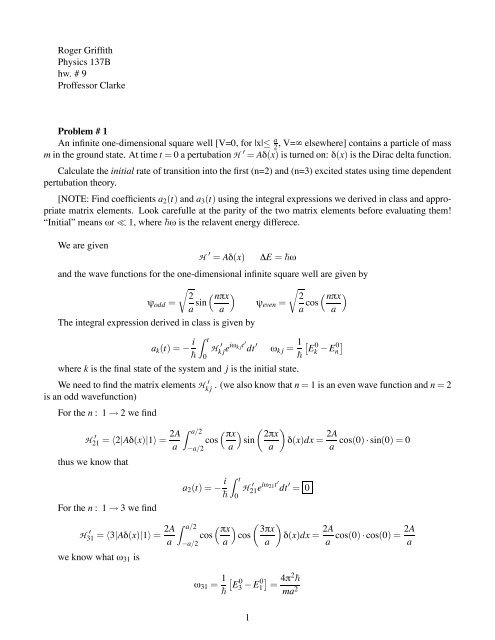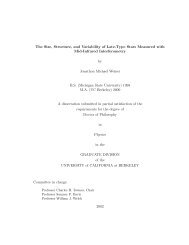Roger Griffith Physics 137B hw. # 9 Proffessor Clarke Problem # 1 ...
Roger Griffith Physics 137B hw. # 9 Proffessor Clarke Problem # 1 ...
Roger Griffith Physics 137B hw. # 9 Proffessor Clarke Problem # 1 ...
Create successful ePaper yourself
Turn your PDF publications into a flip-book with our unique Google optimized e-Paper software.
<strong>Roger</strong> <strong>Griffith</strong><br />
<strong>Physics</strong> <strong>137B</strong><br />
<strong>hw</strong>. # 9<br />
<strong>Proffessor</strong> <strong>Clarke</strong><br />
<strong>Problem</strong> # 1<br />
An infinite one-dimensional square well [V=0, for |x|≤<br />
2 a , V=∞ elsewhere] contains a particle of mass<br />
m in the ground state. At time t = 0 a pertubation H ′ = Aδ(x) is turned on: δ(x) is the Dirac delta function.<br />
Calculate the initial rate of transition into the first (n=2) and (n=3) excited states using time dependent<br />
pertubation theory.<br />
[NOTE: Find coefficients a 2 (t) and a 3 (t) using the integral expressions we derived in class and appropriate<br />
matrix elements. Look carefulle at the parity of the two matrix elements before evaluating them!<br />
“Initial” means ωt ≪ 1, where ω is the relavent energy differece.<br />
We are given<br />
H ′ = Aδ(x)<br />
ΔE = ω<br />
and the wave functions for the one-dimensional infinite square well are given by<br />
√<br />
2<br />
( nπx<br />
)<br />
√<br />
2<br />
( nπx<br />
)<br />
ψ odd =<br />
a sin ψ even =<br />
a<br />
a cos a<br />
The integral expression derived in class is given by<br />
Z t<br />
a k (t) = − i H k ′<br />
j<br />
<br />
eiω k jt ′ dt ′ ω k j = 1 [<br />
E<br />
0<br />
0<br />
k − En]<br />
0<br />
where k is the final state of the system and j is the initial state.<br />
We need to find the matrix elements H<br />
k ′<br />
j<br />
. (we also know that n = 1 is an even wave function and n = 2<br />
is an odd wavefunction)<br />
For the n : 1 → 2 we find<br />
H ′<br />
21 = 〈2|Aδ(x)|1〉 = 2A a<br />
thus we know that<br />
Z a/2<br />
−a/2<br />
cos<br />
( πx<br />
)<br />
sin<br />
a<br />
( 2πx<br />
a<br />
)<br />
δ(x)dx = 2A a<br />
cos(0) · sin(0) = 0<br />
For the n : 1 → 3 we find<br />
H ′<br />
31 = 〈3|Aδ(x)|1〉 = 2A a<br />
we know what ω 31 is<br />
a 2 (t) = − i <br />
Z a/2<br />
−a/2<br />
cos<br />
Z t<br />
0<br />
( πx<br />
)<br />
cos<br />
a<br />
H ′<br />
21 eiω 21t ′ dt ′ = 0<br />
( 3πx<br />
a<br />
)<br />
δ(x)dx = 2A a cos(0) · cos(0) = 2A a<br />
ω 31 = 1 [<br />
E<br />
0<br />
3 − E1<br />
0 ] 4π 2 =<br />
ma 2<br />
1
we will need to use the following identity for the next part<br />
we find the coefficient to be<br />
2isin(ω 31 t/2) = e iω 31t/2 − e −iω 31t/2<br />
so we get<br />
a 3 (t) = − i <br />
Z t<br />
H ′<br />
0<br />
= − 2A<br />
a eiω 31t/2<br />
The rate of transition is given by<br />
31 eiω 31t ′ dt ′ = − 2Ai Z t<br />
e iω 31t ′ dt ′ = − 2A [ e<br />
iω 31 t ]<br />
− 1<br />
t<br />
a 0<br />
a ω 31 t<br />
[<br />
]<br />
e iω31t/2 − e −iω 31t/2<br />
t = − 2A [ isin(ω31 t/2)<br />
ω 31 t<br />
a eiωt/2 ω 31 t/2<br />
a 3 (t) = − 2A<br />
a eiω 31t/2<br />
[ isin(ω31 t/2)<br />
ω 31 t/2<br />
]<br />
t<br />
]<br />
t<br />
|a 3 (t)| 2<br />
t<br />
=<br />
( ) 2A 2 ( )<br />
a t sin(ω31 t/2) 2<br />
since ω 31 t ≪ 1<br />
ω 31 t/2<br />
sin(ω 31 t/2)<br />
ω 31 t/2<br />
⇒ 1<br />
we get<br />
|a 3 (t)| 2<br />
t<br />
= 4A2<br />
2 a 2 t<br />
<strong>Problem</strong> # 2<br />
A hydrogen atom in its ground state is placed between the parallel plates of a capacitor. The z-axis<br />
of the atom in perpendicular to the capacitor plates. At time t = 0, a uniform electric field⃗ε =⃗ε 0 e −t/τ is<br />
applied to the atom. The perturbing Hamiltonian is thus<br />
H ′ = −e⃗r ·⃗ε 0 e −t/τ = −ezε 0 e −t/τ<br />
and since z is given by z = r cos(θ)<br />
we find the Hamiltonian to be<br />
H ′ = −er cos(θ)ε 0 e −t/τ<br />
and the three hydrogen wave functions needed for this problem are given as<br />
ψ 100 = √<br />
1 e −r/a 0<br />
ψ 200 = 1 (<br />
1<br />
√ 1 − r )<br />
e −r/2a 0<br />
ψ 210 = 1<br />
πa 3 2πa0 2a 0 2a 0<br />
0<br />
√<br />
2π<br />
1<br />
4a 5/2<br />
0<br />
cos(θ)e −r/2a 0<br />
(a) Show that the electron has zero probability of being excited into the 2s state Ψ nlm = Ψ 200<br />
what we are looking for is |a 200 (t)| 2 so we must use the formula<br />
a 200 (t) = − i <br />
Z t<br />
0<br />
H ′<br />
k j eiω k jt ′ dt ′<br />
2
where<br />
H ′<br />
200,100 = 〈200| − er cos(θ)ε 0 e −t/τ |100〉 = −eε 0 e −t/τ 〈200|r cos(θ)|100〉<br />
= − eε 0e −t/τ Z 2π Z π<br />
Z ∞<br />
(<br />
√ dφ cos(θ)sin(θ)dθ r 3 1 − r )<br />
e −3r/2a 0<br />
dr<br />
8πa<br />
3<br />
0<br />
2a 0<br />
0<br />
0<br />
0<br />
but since we know that<br />
causes<br />
Z π<br />
0<br />
cos(θ)sin(θ)dθ = 0<br />
H ′<br />
200,100 = 0<br />
and thus<br />
a 200 (t) = − i Z t<br />
H k ′<br />
j<br />
<br />
eiω k jt ′ dt ′ = 0<br />
0<br />
and if you square this number, you still get 0 thus the probability of this transition happening is nill.<br />
(b) Show that after time t ≫ τ, the probability that the atom is in the 2p state Ψ nlm = Ψ 210 is<br />
|a 210 (t)| 2 = 215<br />
3 10 e 2 ε 2 0 a2 0<br />
2 (ω 2 + 1/τ 2 )<br />
we must first find the matrix element H<br />
210,100 ′ which is given by<br />
H ′<br />
210,100 = 〈210| − er cos(θ)ε 0 e −t/τ |100〉 = −eε 0 e −t/τ 〈210|r cos(θ)|100〉<br />
= − eε 0e −t/τ Z 2π<br />
√ dφ<br />
8πa<br />
4<br />
0<br />
and so we find the integrals to be<br />
Z 2π<br />
0<br />
Z π<br />
dφ cos 2 (θ)sin(θ)dθ<br />
0<br />
0<br />
Z π<br />
0<br />
cos 2 (θ)sin(θ)dθ<br />
Z ∞<br />
0<br />
r 4 e −3r/2a 0<br />
dr<br />
letting u = cos(θ) du = −sin(θ)dθ<br />
thus we find<br />
Z 2π Z π<br />
Z −1<br />
dφ cos 2 (θ)sin(θ)dθ = 2π u 2 du = 4π<br />
0 0<br />
1 3<br />
and for the other integral we find<br />
putting this all together we get<br />
Z ∞<br />
0<br />
(<br />
r 4 e −3r/2a 2a0<br />
0<br />
dr = 4!<br />
3<br />
) 5<br />
H 210,100 ′ = −eε 0e −t/τ ( )<br />
4π<br />
5<br />
√<br />
8πa<br />
4<br />
0<br />
3 4! 2a0<br />
= − 28 a 0<br />
3 3 5√ 2 eε 0e −t/τ<br />
3
now that we have this solution we can find the coefficient. Plugging this into the equation derived in<br />
class we find<br />
but since we know that<br />
Z t<br />
0<br />
a 210 (t) = − i <br />
e t′ (iω−1/τ) dt ′ =<br />
and so we find the coefficient to be given as<br />
and the probability is given by<br />
= ieε 0<br />
<br />
Z t<br />
0<br />
H ′<br />
k j eiω k jt ′ dt ′<br />
a<br />
√ 0 2 8<br />
2<br />
1<br />
iω − 1/τ<br />
for t ≫ τ e t(iω−1/τ) → 0<br />
a 210 (t) = − ieε 0<br />
<br />
( )<br />
a0 2<br />
8<br />
(<br />
√<br />
2 3 5<br />
Z t<br />
3 5 e t′ (iω−1/τ) dt ′<br />
0<br />
[<br />
]<br />
e t(iω−1/τ) − 1<br />
)<br />
1<br />
iω − 1/τ<br />
|a 210 (t)| 2 = a 210 (t)a 210 (t) ∗ = 215<br />
3 10 e 2 ε 2 0 a2 0<br />
2 (ω 2 + 1/τ 2 )<br />
4












![Problem #1 [Structure Formation I: Radiation Era]](https://img.yumpu.com/37147371/1/190x245/problem-1-structure-formation-i-radiation-era.jpg?quality=85)



